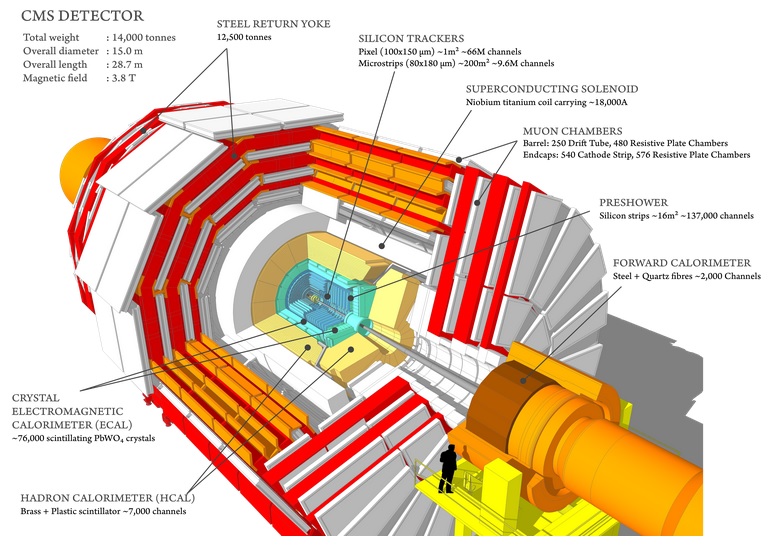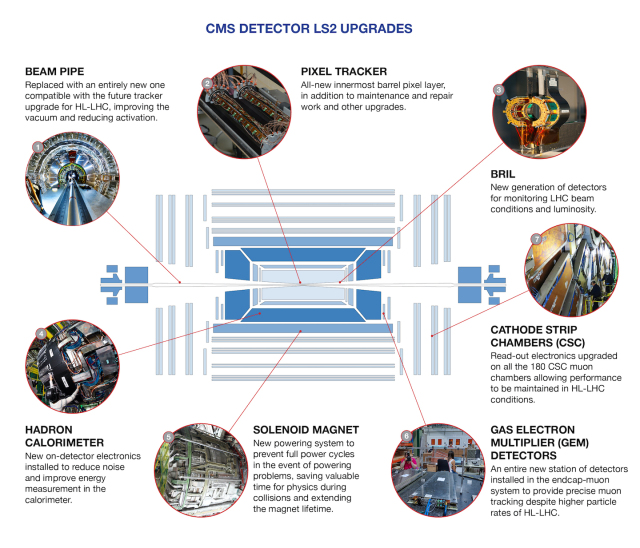Taking a closer look at LHC
|
CMS (Compact Muon Solenoid) is one of two general-purpose LHC experiments (ATLAS is the other) designed to explore the physics of the Terascale, the energy region where physicists believe they will find answersto the central questions at the heart of 21st-century particle physics: Are there undiscovered principles of nature? How can we solve the mystery of dark energy? Are there extra dimensions of space? How did the universe come to be? CMS, in collaboration with ATLAS, contributed to the discovery of a Higgs Boson in 2012-13. |
 |
The main volume of the CMS detector is a multilayered cylinder, some 21 m long and 16 m in diameter, weighing more than 13000 tons. The innermost layer is a silicon-based particle tracker, surrounded by a scintillating crystal electromagnetic calorimeter which is itself surrounded with a sampling calorimeter for hadrons measuring particle energies. They fit inside a central superconducting solenoid magnet (3,8 Tesla), 13 m feet long and 6 m in diameter, that measures the momenta of charged particles. Outside the magnet are the large muon detectors, which are inside the return yoke of the magnet.

CMS has over 4000 particle physicists, engineers, computer scientists, technicians and students from around 240 institutes and universities from more than 50 countries.
More information here...
CMS Live
(Taken from MELTRONX ©2009-2024. A Real Frisco Kid Production Not Affiliated with CERN)
At each Long Shutdown (LS) the various accelerators, detectors and other devices undergo major maintenance, consolidation and upgrade operations.
During the long shutdown LS2, CMS scientists refurbished the Pixel Tracker, which sits a mere 2.9 centimeters away from the beam pipe, where particles circulate and collide. Around 600 million particles pass through 1 square centimeter of this inner detector every second. To keep track of the number of particles, scientists upgraded a detector close to the pixel tracker called BRIL, which will monitor the experimental conditions and help scientists calibrate their data.
The CMS experiment also completed the installation of their newly designed Gas Electron Multiplier detectors, which will detect muons close to the beam pipe. In addition, CMS scientists have implemented new software to help the experiment quickly filter and process their data.
[These comments are taken from What’s new for LHC Run 3? By Sarah Charley. Symmetry (A joint Fermilab/SLAC publication)]
In more detail we can see the improvements made to this detector during LS2 (2019-2022) in thge next image:
All information in CMS Upgrades LS2
The image at the bottom of the DETECTORS Section shows some of those performed on the larger detectors during LS2 (2019-2022).
|
AUTHORS Xabier Cid Vidal, PhD in experimental Particle Physics for Santiago University (USC). Research Fellow in experimental Particle Physics at CERN from January 2013 to Decembre 2015. He was until 2022 linked to the Department of Particle Physics of the USC as a "Juan de La Cierva", "Ramon y Cajal" fellow (Spanish Postdoctoral Senior Grants), and Associate Professor. Since 2023 is Senior Lecturer in that Department.(ORCID). Ramon Cid Manzano, until his retirement in 2020 was secondary school Physics Teacher at IES de SAR (Santiago - Spain), and part-time Lecturer (Profesor Asociado) in Faculty of Education at the University of Santiago (Spain). He has a Degree in Physics and a Degree in Chemistry, and he is PhD for Santiago University (USC) (ORCID). |
CERN CERN Experimental Physics Department CERN and the Environment |
LHC |
IMPORTANT NOTICE
For the bibliography used when writing this Section please go to the References Section
© Xabier Cid Vidal & Ramon Cid - rcid@lhc-closer.es | SANTIAGO (SPAIN) |





